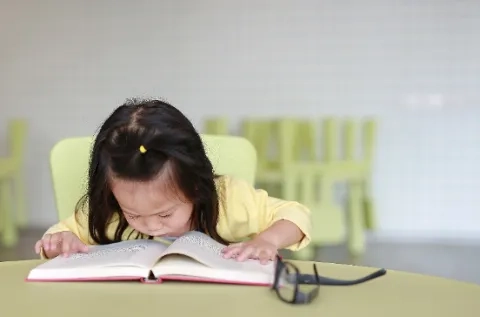Common myths about your child’s eyes

#1 – My child can only have an eye check when he/she is literate and verbal
Untrue! Paediatric optometrists are equipped with special tools that enable them to examine the visual ability of a child without the need for much verbal feedback at all. It is important to evaluate and monitor your child’s eye health as his/her eyes are constantly developing and changing as he/she grows1. In fact, it is essential to have your child’s first eye check when he/she turns 6 months old2, followed by an annual review.
#2 – Short-sightedness is inherited and no prevention can be done

Studies have shown familial link in children with parents who have short-sightedness (myopia). Having one myopic parent increases the child’s risk of turning myopic by 2-3 times, whereas if both parents are myopic, the risk increases by up to 6 times3.
Although myopia is inheritable, it does not necessarily mean that all children with myopic parents will be affected. The environment that they usually spend their time in also plays a major factor. Experts have recommended that children should take regular breaks in between near work and also spending more time outdoors to help reduce myopia onset4.
#3 – Being exposed to sunlight can damage my child’s eyes

It may be true that long-term sun exposure without proper eye protection can increase the risk of eye disease. However, various studies have claimed that sun exposure is important and necessary for normal visual development5. Research has shown that young children who have lesser sun exposure may be at higher risk of developing myopia or short sightedness.
Avoid outdoor playtime during the hottest time of the day i.e. noon time; and always remember to apply sunscreen or wear a cap when your child is playing outdoors.
#4 - If my child has myopia and/or astigmatism, he/she can be treated easily by a pair of spectacles or contact lenses

Although your child can be functionally treated with optical aids such as spectacles or contact lenses to help them to see as per normal vision, the risk of visual impairment is strongly related to the elongation of the eye ball and refractive power in eye. This means your child is still at risk of myopia-related diseases6.
#5 - My child is still young. He/she should not wear spectacles because that will cause his/her eyesight to deteriorate

Incorrect! Not wearing spectacles will not stop a refractive error from worsening, especially when it is required and recommended.
On the contrary, your child may end up straining his/her eyes to see better and this can cause myopia to increase faster. If your child is suffering from severe myopia or astigmatism at a very young age, not correcting the refraction errors with spectacles can possibly lead to irreversible amblyopia or lazy eyes6.
#6 - Refractive surgery (e.g. LASIK) is easily available so my child’s eyes can still be corrected to normal
This is a common misconception that is believed by majority. Refractive surgery changes the front part (cornea) of your child’s eyes only to help him/her to see well, while the length of his/her eyes still remains as elongated65. Therefore, your child’s risks of myopia complications are the same as someone with or without refractive surgery.
#7 - Myopia will not cause blindness

Myopia requires early intervention as it can be a complex condition that is associated with major eye diseases. If your child has high myopia, some complications include an increased risk in glaucoma, cataracts, retinal detachment and myopic macular degeneration in adulthood, and these can be vision threatening which may eventually lead to blindness6,7.
#8 - Vision loss only happens to adults

Amblyopia happens when vision in one eye is reduced because the eye and brain are not coordinated to work properly. A child with amblyopia (lazy eye) may have a pair of normal looking eyes, but this eye condition can steal sight if it goes undetected and not treated promptly5.
Strabismus (crossed eyes) and undetected refractive errors (myopia, astigmatism, etc) are some examples which can lead to amblyopia and possibly cause vision loss in a child.
References:
- Childhood eye myths. Mount Elizabeth website. https://www.mountelizabeth.com.sg/healthplus/article/childhood-eye-myths
- Infant Vision: Birth to 24 Months of Age. American Optometric Association. https://www.aoa.org/patients-and-public/good-vision-throughout-life/childrens-vision/infant-vision-birth-to-24-months-of-age.
- Mutti D, Mitchell L, Moeschberger M, Jones L, Zadnik K. Parental Myopia, Near Work, School Achievement, and Children’s Refractive Error. Investigative Opthalmology & Visual Science. December 2002; 43(12): 3633-3640.
- Rose KA, Morgan IG, Ip J, Kifley A, Huynh S, Smith W, Mitchell P. Outdoor activity reduces the prevalence of myopia in children. Opthalmology. 2008 Aug;115(8): 1279-85.
- Seven myths about children’s eyes. American Academy of Ophthalmology website. https://www.aao.org/newsroom/news-releases/detail/seven-myths-about-childrens-eyes
- Debunking Myths. Singapore National Eye Centre website. https://www.snec.com.sg/patient-care/specialties-and-services/clinics-centres/myopia-centre/debunking-myths
- Can myopia lead to blindness? All About Vision website. https://www.allaboutvision.com/conditions/myopia-faq/can-myopia-lead-to-blindness.htm
- Education. BHVI website. https://bhvi.org/education.html
Recent Blog Posts
- 19 Oct 2022
- 19 Oct 2022
- 19 Oct 2022
- 19 Oct 2022
- 19 Oct 2022
